- Cabinets & Chests
- A GEORGE I SECRETAIRE BUREAU ATTRIBUTED TO COXED & WOSTER
A GEORGE I SECRETAIRE BUREAU ATTRIBUTED TO COXED & WOSTER
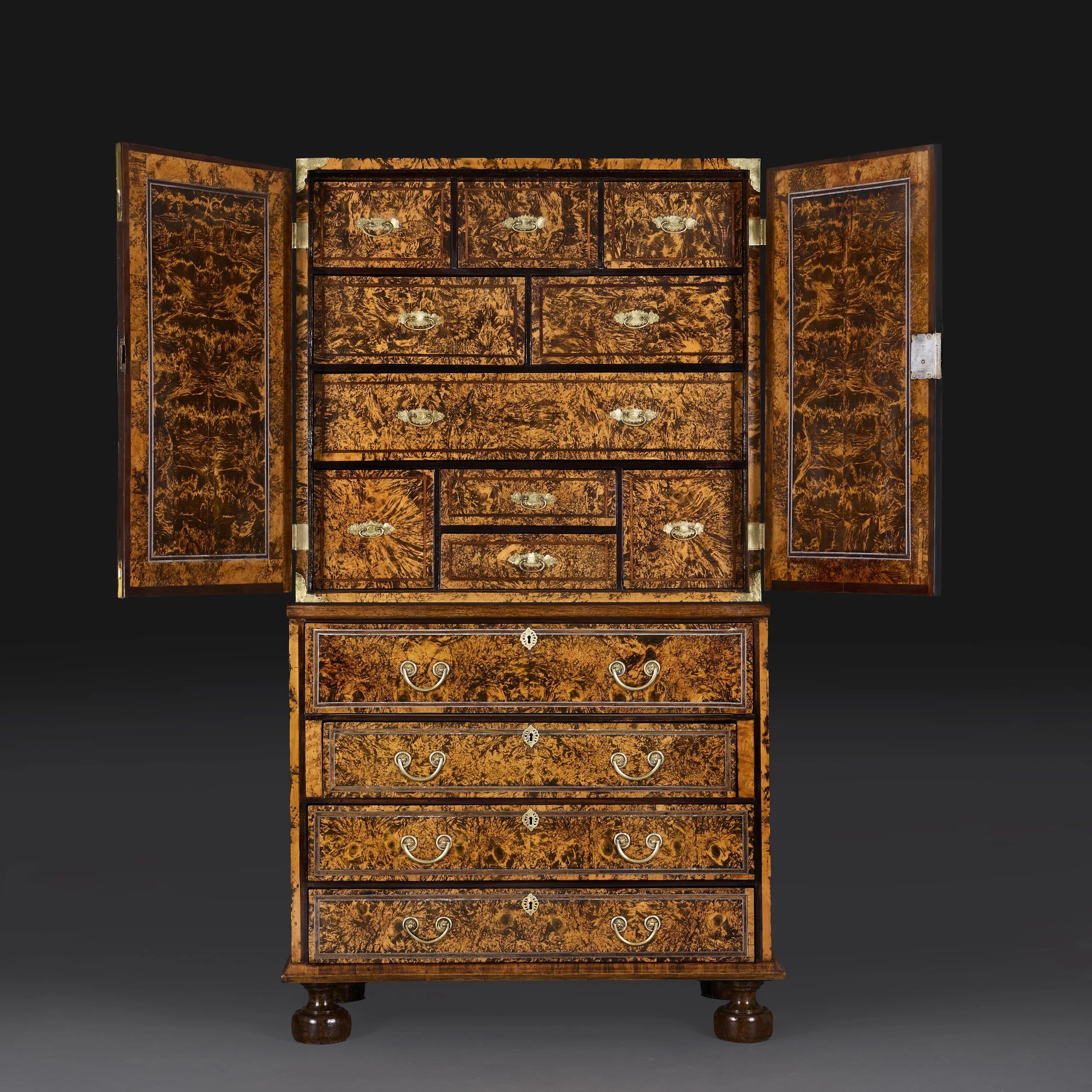
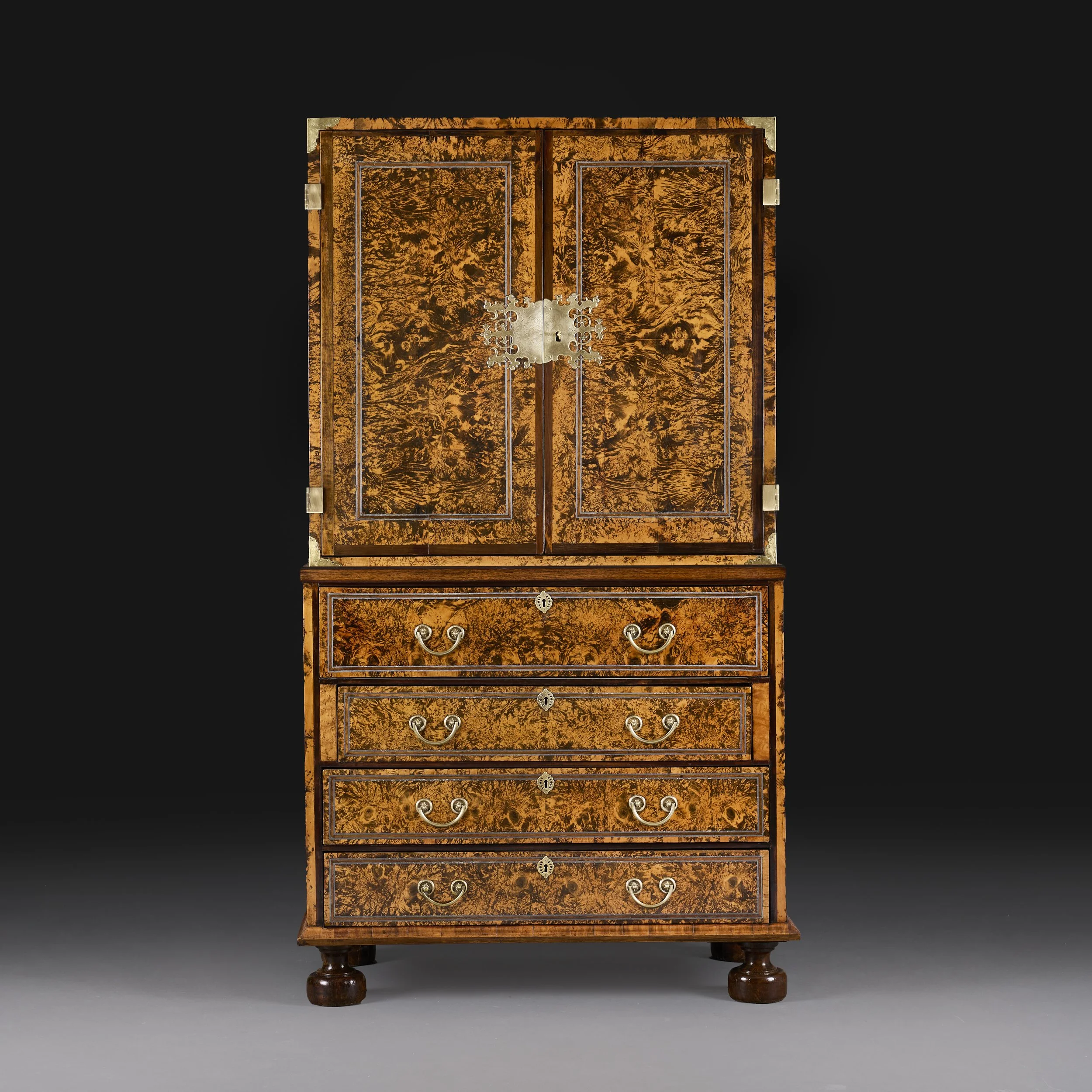
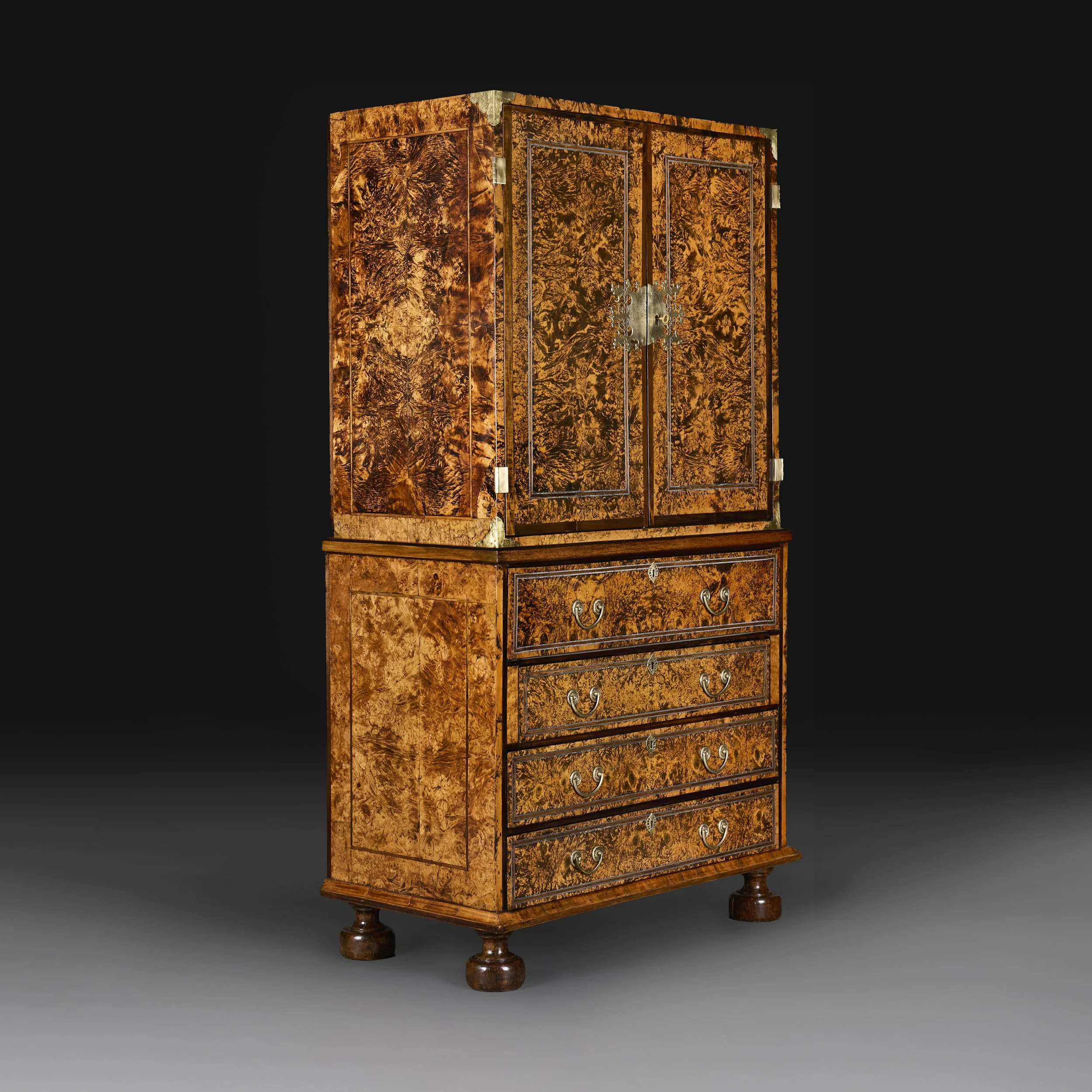
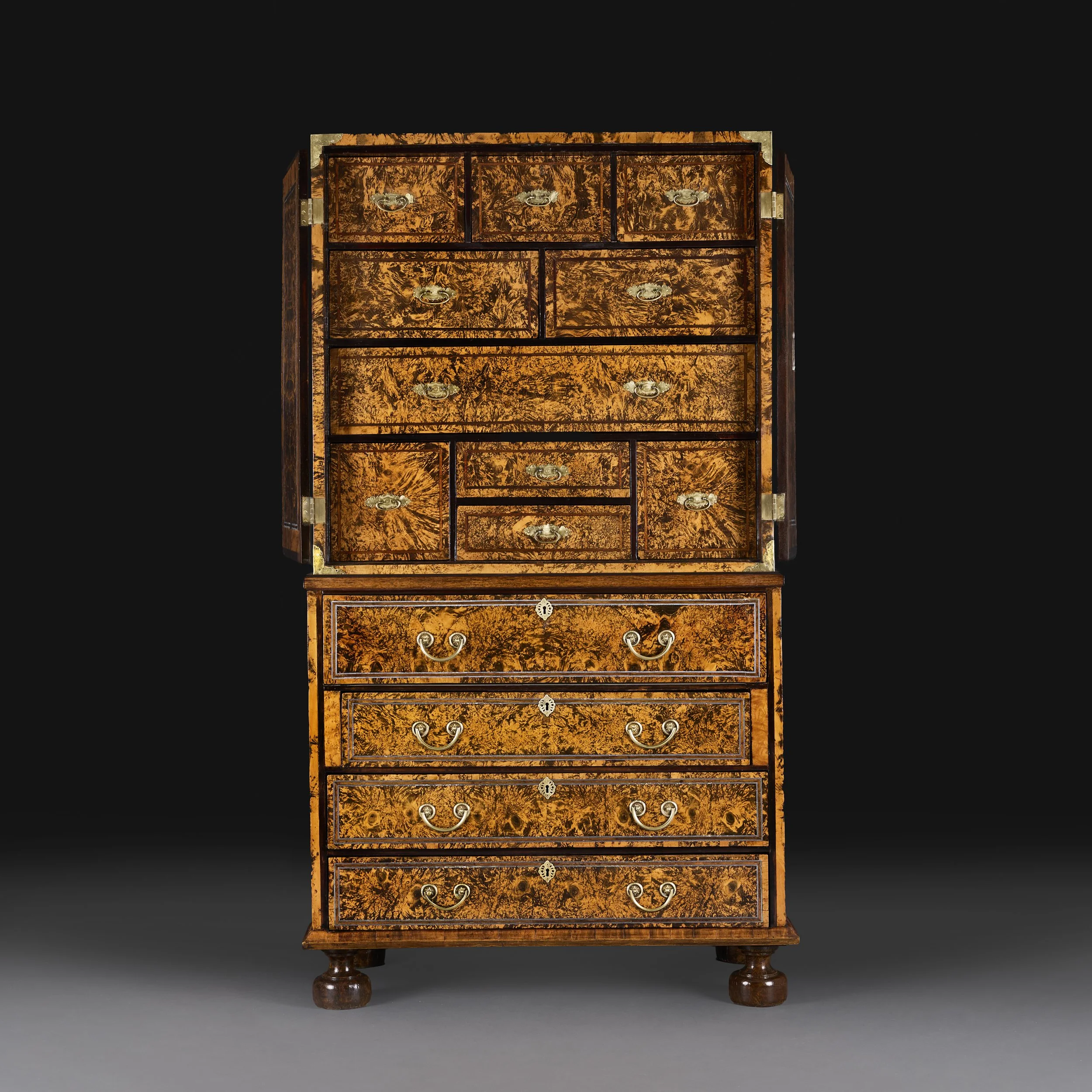
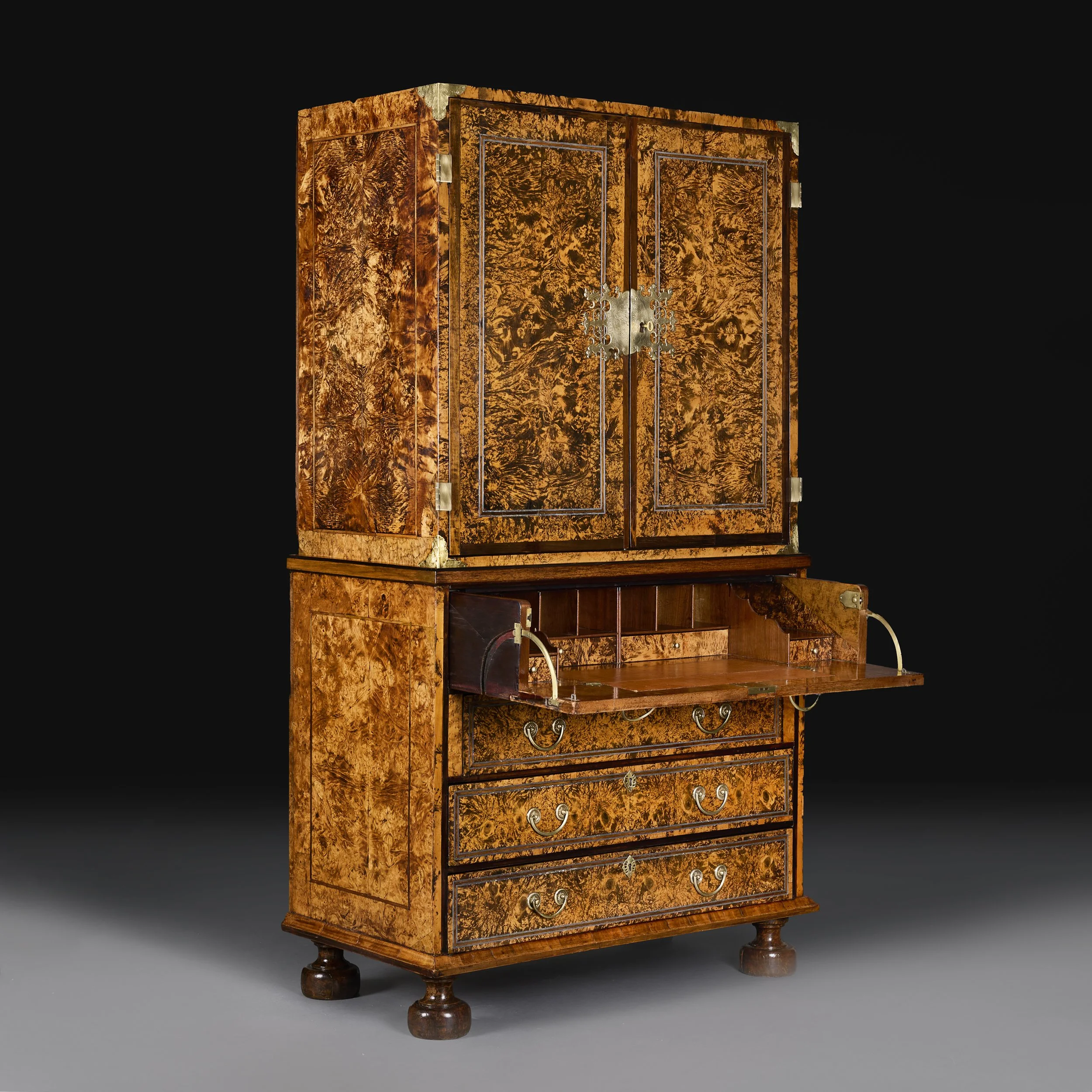
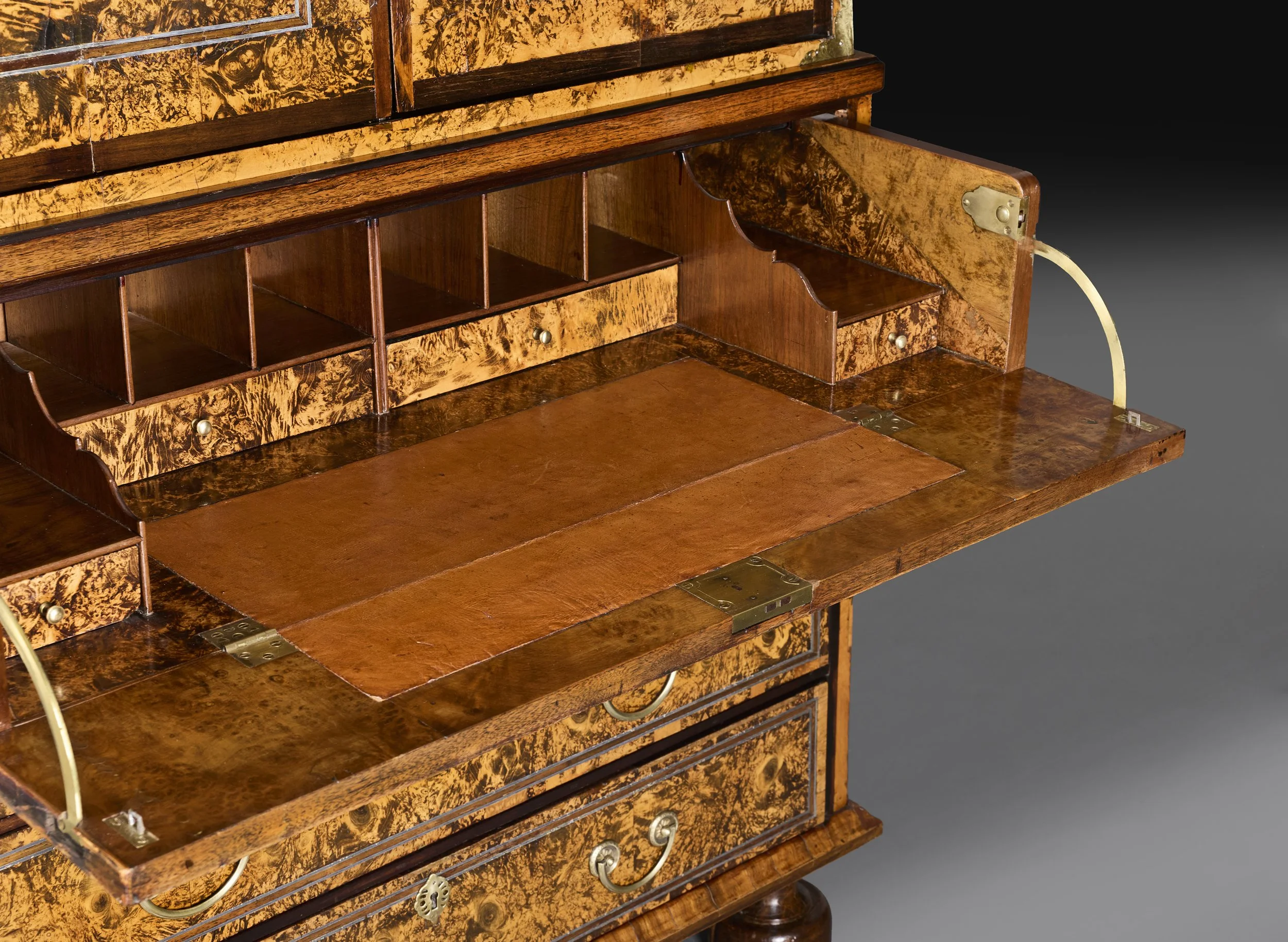

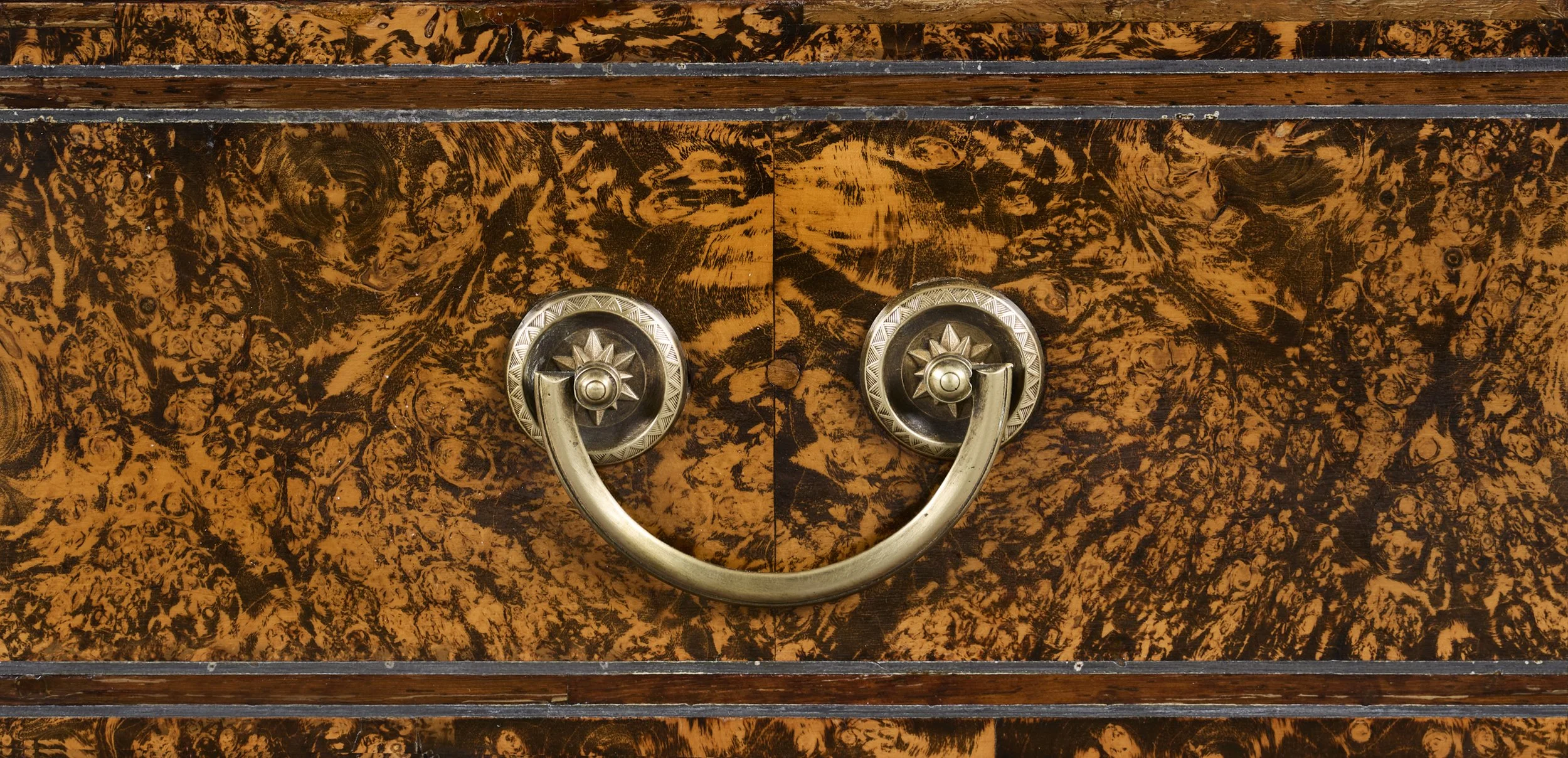
A GEORGE I SECRETAIRE BUREAU ATTRIBUTED TO COXED & WOSTER
England, circa 1710
An important George I secretaire bureau in finely veneered ‘mulberry wood’ attributed to Coxed & Woster, with satinwood crossbanding, rosewood mouldings and pewter string inlay. The top with parliament hinged doors and oriental brass mounts, opening to reveal an arrangement of ten drawers with original engraved brass handles, the bottom with three drawers below a hinged secretaire desk lined with brown leather and further shelves, all terminated in four bun feet.
Height 184.00cm
Width 98.00cm
Depth 52.00cm
Attributed to London cabinetmakers Coxed & Woster, based in the White Swan workshop on the south side of St. Paul’s Churchyard from c.1690-1736. Similarities can be found in this bureau to a group of examples bearing the trade paper label for G. Coxed and T. Woster. The earliest examples are veneered with what is commonly termed ‘mulberry’, a timber that originally was thought to have come from the mulberry bush or tree but has been recently identified as stained maple, burr elm or sycamore to give a dramatic tortoiseshell effect. In Stalker and Parker's treatise on japanning, a section outlines the technique of using nitric acid or aqua fortis, metal filings and lampblack mixes with linseed oil to produce ‘mulberry wood’. If actual mulberry wood is ebonized to reinforce its markings it does not take the staining effectively whereas with elm, maple and sycamore have more porous parts in the grain which retains the dark streaks to produce this dramatic tortoiseshell-like appearance. It is believed that very few British cabinet makers knew how to create this effect and that the staining process was hotly guarded, with Coxed & Woster being prominent exponents. The popularity of these veneers in the 1690-1730 period is thought to stem from the use of tortoiseshell in the fashionable and influential designs produced by famed French cabinet makers Pierre Golle and André Charles Boulle. (For more information on the use of aqua fortis see A. Bowett, Early Georgian Furniture 1715-1740, Antique Collector's Club, 2009, p.311.)
Further to the expertly stained ‘mulberry wood’ on this bureau, there is kingwood crossbanding, rosewood mouldings and pewter inlay, all further details which recur in Coxed and Woster pieces and reinforce this attribution. (See R.Edwards & M.Jourdain, Georgian Cabinet-Makers, p.91-92, plates 212-213.) The use of metal line inlay was almost certainly due to the influence of Gerrit Jensen who introduced such Continental techniques into England in the late 17th century. The bureau also features distinctly Japanese corner hinges which are clearly influenced by the lacquer cabinets-on-stands that came to Europe via the Dutch East India Company and became prized collector’s pieces. These hinges contrast with the European practice of concealed hinges to the interior of cabinet doors, and often make an appearance on English pieces that have been ‘japanned’ to imitate lacquer (as on the piece pictured as plates 3:82 and 3:83 in Adam Bowett’s Early Georgian Furniture 1715-1740). When they do appear on cabinets of more English form, they tend to be attributed to Coxed & Woster on account of the labelled examples figs. 241 and 242 as pictured in Christopher Gilbert’s Pictorial Dictionary of Marked London Furniture 1700-1840. For instance, a wood-veneered example with these Japanese-style hinges was offered at Christie’s New York, 14th October 2004, lot 41. These distinctive hinges also often overlap with the ‘mulberry’ staining to the veneers and pewter stringing, both seen on the above-mentioned examples.
Adam Bowett & Laurie Lindey, Literature: Furniture History, The Journal of The Furniture History Society, Vol. XXXIX, 2013 ‘Labelled furniture from the White Swan workshop’, pp 71-98.
Adam Bowett, English Furniture 1660 - 1714 From Charles II to Queen Anne, pp 224-226
Adam Bowett, Early Georgian Furniture 1715-1740, Woodbridge, 2009, pp.138-139, pl.3:82 and 3:83.
R. Edwards & M. Jourdain, Georgian Cabinet-Makers, p.91-92
Christopher Gilbert, Pictorial Dictionary of Marked London Furniture 1700-1840, Leeds, 1996, pp.156-157, figs. 241 and 242.
England, circa 1710
An important George I secretaire bureau in finely veneered ‘mulberry wood’ attributed to Coxed & Woster, with satinwood crossbanding, rosewood mouldings and pewter string inlay. The top with parliament hinged doors and oriental brass mounts, opening to reveal an arrangement of ten drawers with original engraved brass handles, the bottom with three drawers below a hinged secretaire desk lined with brown leather and further shelves, all terminated in four bun feet.
Height 184.00cm
Width 98.00cm
Depth 52.00cm
Attributed to London cabinetmakers Coxed & Woster, based in the White Swan workshop on the south side of St. Paul’s Churchyard from c.1690-1736. Similarities can be found in this bureau to a group of examples bearing the trade paper label for G. Coxed and T. Woster. The earliest examples are veneered with what is commonly termed ‘mulberry’, a timber that originally was thought to have come from the mulberry bush or tree but has been recently identified as stained maple, burr elm or sycamore to give a dramatic tortoiseshell effect. In Stalker and Parker's treatise on japanning, a section outlines the technique of using nitric acid or aqua fortis, metal filings and lampblack mixes with linseed oil to produce ‘mulberry wood’. If actual mulberry wood is ebonized to reinforce its markings it does not take the staining effectively whereas with elm, maple and sycamore have more porous parts in the grain which retains the dark streaks to produce this dramatic tortoiseshell-like appearance. It is believed that very few British cabinet makers knew how to create this effect and that the staining process was hotly guarded, with Coxed & Woster being prominent exponents. The popularity of these veneers in the 1690-1730 period is thought to stem from the use of tortoiseshell in the fashionable and influential designs produced by famed French cabinet makers Pierre Golle and André Charles Boulle. (For more information on the use of aqua fortis see A. Bowett, Early Georgian Furniture 1715-1740, Antique Collector's Club, 2009, p.311.)
Further to the expertly stained ‘mulberry wood’ on this bureau, there is kingwood crossbanding, rosewood mouldings and pewter inlay, all further details which recur in Coxed and Woster pieces and reinforce this attribution. (See R.Edwards & M.Jourdain, Georgian Cabinet-Makers, p.91-92, plates 212-213.) The use of metal line inlay was almost certainly due to the influence of Gerrit Jensen who introduced such Continental techniques into England in the late 17th century. The bureau also features distinctly Japanese corner hinges which are clearly influenced by the lacquer cabinets-on-stands that came to Europe via the Dutch East India Company and became prized collector’s pieces. These hinges contrast with the European practice of concealed hinges to the interior of cabinet doors, and often make an appearance on English pieces that have been ‘japanned’ to imitate lacquer (as on the piece pictured as plates 3:82 and 3:83 in Adam Bowett’s Early Georgian Furniture 1715-1740). When they do appear on cabinets of more English form, they tend to be attributed to Coxed & Woster on account of the labelled examples figs. 241 and 242 as pictured in Christopher Gilbert’s Pictorial Dictionary of Marked London Furniture 1700-1840. For instance, a wood-veneered example with these Japanese-style hinges was offered at Christie’s New York, 14th October 2004, lot 41. These distinctive hinges also often overlap with the ‘mulberry’ staining to the veneers and pewter stringing, both seen on the above-mentioned examples.
Adam Bowett & Laurie Lindey, Literature: Furniture History, The Journal of The Furniture History Society, Vol. XXXIX, 2013 ‘Labelled furniture from the White Swan workshop’, pp 71-98.
Adam Bowett, English Furniture 1660 - 1714 From Charles II to Queen Anne, pp 224-226
Adam Bowett, Early Georgian Furniture 1715-1740, Woodbridge, 2009, pp.138-139, pl.3:82 and 3:83.
R. Edwards & M. Jourdain, Georgian Cabinet-Makers, p.91-92
Christopher Gilbert, Pictorial Dictionary of Marked London Furniture 1700-1840, Leeds, 1996, pp.156-157, figs. 241 and 242.